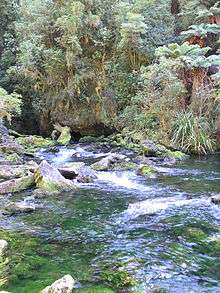Nettlebed Cave


Nettlebed Cave is a limestone cave located in the Mount Arthur region of the northwest South Island of New Zealand. The presence of ongaonga (Urtica ferox), an endemic tree nettle, near the bottom entrance gives the cave its name.
Until April 2010, when the nearby Ellis Basin cave system was found to be deeper,[1] Nettlebed Cave was thought to be the deepest cave system in the southern hemisphere. It drops 889 metres below its upper entrance (Blizzard Pot) to its lower exit (the Pearse River resurgence), and its 24 kilometres of cave passages make it New Zealand's third longest cave.
In January 2014 a group of cavers established that the Nettlebed Cave was connected to the Stormy Pot Cave.
Exploration
Nettlebed Cave was first explored by cavers in 1969 through the dry overflow passage of a large spring pouring into the Pearse River. By 1973 1.3 kilometres of passages had been mapped. It was not until 1979 that a flowstone squeeze known as the Hinkle-horn-honking-holes was passed, making further explorations possible. Five successive Christmas expeditions (1979-80 through 1983-84) utilising an underground camp at Salvation Hall led to the exploration and mapping of a further 20 kilometres.
In 1986 another cave (Blizzard Pot) was connected with Nettlebed Cave, providing an upper entrance to the system.
On 21 March 2007, a team of international cave divers set a New Zealand cave diving record by reaching a depth of 177m (581 feet below ground level) in the Pearse Resurgence.[2]
In 2011, divers reached 194 metres depth, by placing four decompression habitats along the cave main tunnel,[3] but were still unable to trace the source.
References
- ↑ Andrew Board (2010-04-13). "Historic discovery by NZ cavers". Nelson Mail.
- ↑ Dive New Zealand site "
- ↑
Further reading
- Pugsley, C. Caves of the Mount Arthur Region Caving International #4, 1979
- Atlas - Great Caves of the World Cave Books, 1989
External links
Coordinates: 41°15′18″S 172°41′34″E / 41.2550°S 172.6928°E